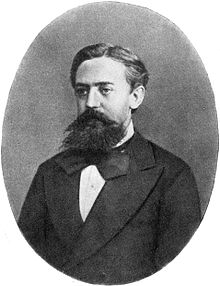Andrey Markov
This article needs additional citations for verification. (May 2023) |
Andrey Markov | |
|---|---|
Андрей Марков | |
St. Petersburg University | |
| Doctoral advisor | Pafnuty Chebyshev |
| Doctoral students |
|
Andrey Andreyevich Markov[a] (14 June 1856 – 20 July 1922) was a Russian mathematician best known for his work on stochastic processes. A primary subject of his research later became known as the Markov chain.[2] He was also a strong, close to master-level chess player.
Markov and his younger brother
Biography
Andrey Markov was born on 14 June 1856 in Russia. He attended the St. Petersburg Grammar School, where some teachers saw him as a rebellious student. In his academics he performed poorly in most subjects other than mathematics. Later in life he attended Saint Petersburg Imperial University (now
Timeline
In 1877, Markov was awarded a gold medal for his outstanding solution of the problem
About Integration of Differential Equations by
During the following year, he passed the candidate's examinations, and he remained at the university to prepare for a lecturer's position.
In April 1880, Markov defended his master's thesis "On the Binary Square Forms with Positive Determinant", which was directed by Aleksandr Korkin and Yegor Zolotarev. Four years later in 1884, he defended his doctoral thesis titled "On Certain Applications of the Algebraic Continuous Fractions".
His pedagogical work began after the defense of his master's thesis in autumn 1880. As a privatdozent he lectured on differential and integral calculus. Later he lectured alternately on "introduction to analysis", probability theory (succeeding Chebyshev, who had left the university in 1882) and the calculus of differences. From 1895 through 1905 he also lectured in differential calculus.

One year after the defense of his doctoral thesis, Markov was appointed extraordinary professor (1886) and in the same year he was elected adjunct to the Academy of Sciences. In 1890, after the death of Viktor Bunyakovsky, Markov became an extraordinary member of the academy. His promotion to an ordinary professor of St. Petersburg University followed in the fall of 1894.
In 1896, Markov was elected an ordinary member of the academy as the successor of
In connection with student riots in 1908, professors and lecturers of St. Petersburg University were ordered to monitor their students. Markov refused to accept this decree, and he wrote an explanation in which he declined to be an "agent of the governance". Markov was removed from further teaching duties at St. Petersburg University, and hence he decided to retire from the university.
Markov was an

In 1913, the council of St. Petersburg elected nine scientists honorary members of the university. Markov was among them, but his election was not affirmed by the minister of education. The affirmation only occurred four years later, after the February Revolution in 1917. Markov then resumed his teaching activities and lectured on probability theory and the calculus of differences until his death in 1922.
See also
- List of things named after Andrey Markov
- Chebyshev–Markov–Stieltjes inequalities
- Gauss–Markov theorem
- Gauss–Markov process
- Hidden Markov model
- Markov blanket
- Markov chain
- Markov decision process
- Markov's inequality
- Markov brothers' inequality
- Markov information source
- Markov network
- Markov number
- Markov property
- Markov process
- Stochastic matrix (also known as Markov matrix)
- Subjunctive possibility
Notes
References
- hdl:11858/00-001M-0000-002C-4314-2. Archived from the original(PDF) on 10 August 2012. Retrieved 29 August 2012.
- ISBN 978-1-119-38755-8.
- ^ Драгалин (1979). Математический интуиционизм. Введение в теорию доказательств. Наука. p. 256.
- ^ "Of course, Markov, an atheist and eventual excommunicate of the Church quarreled endlessly with his equally outspoken counterpart Nekrasov. The disputes between Markov and Nekrasov were not limited to mathematics and religion, they quarreled over political and philosophical issues as well." Gely P. Basharin, Amy N. Langville, Valeriy A. Naumov, The Life and Work of A. A. Markov, page 6.
- ISBN 978-0-674-03293-4.
Markov (1856–1922), on the other hand, was an atheist and a strong critic of the Orthodox Church and the tzarist government (Nekrasov exaggeratedly called him a Marxist).
Further reading
- Karl-Georg Steffens (28 July 2007). The History of Approximation Theory: From Euler to Bernstein. Springer Science & Business Media. pp. 98–105. ISBN 978-0-8176-4475-8.
- А. А. Марков. "Распространение закона больших чисел на величины, зависящие друг от друга". "Известия Физико-математического общества при Казанском университете", 2-я серия, том 15, с. 135–156, 1906.
- A. A. Markov. "Extension of the limit theorems of probability theory to a sum of variables connected in a chain". reprinted in Appendix B of: R. Howard. Dynamic Probabilistic Systems, volume 1: Markov Chains. John Wiley and Sons, 1971.
- Pavlyk, Oleksandr (4 February 2013). "Centennial of Markov Chains". Wolfram Blog.

